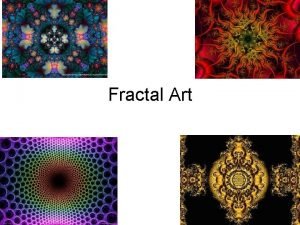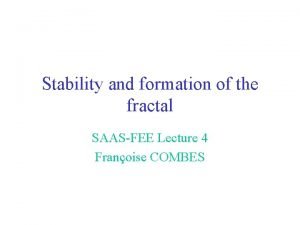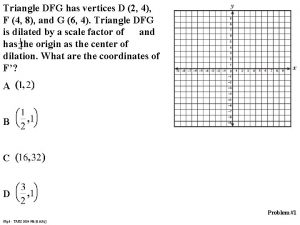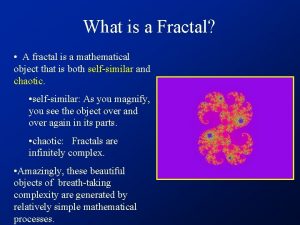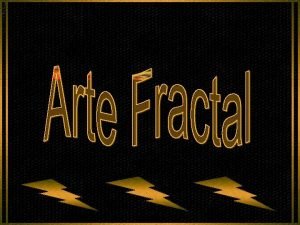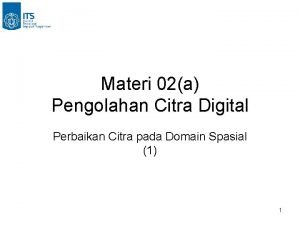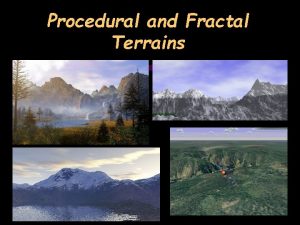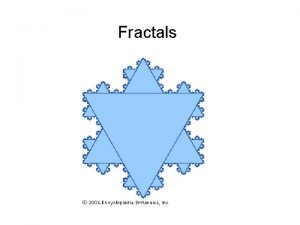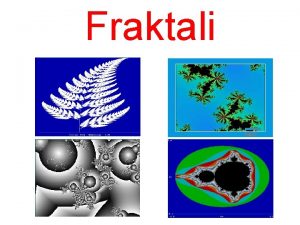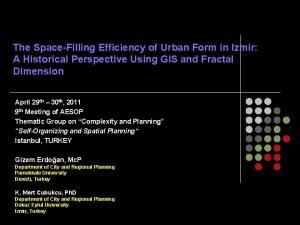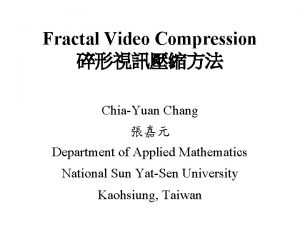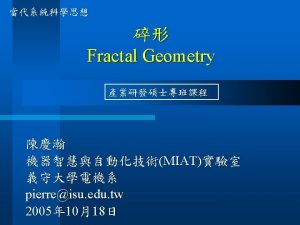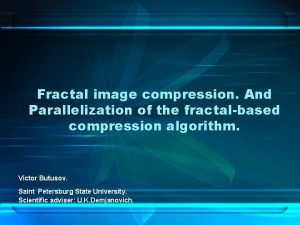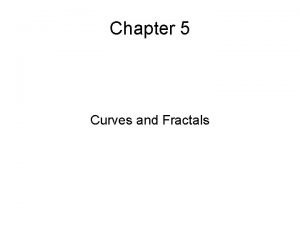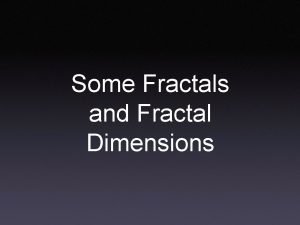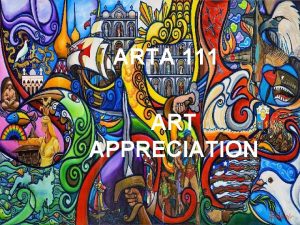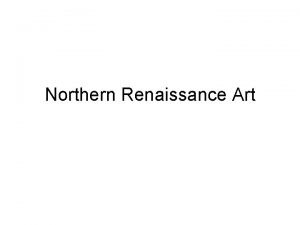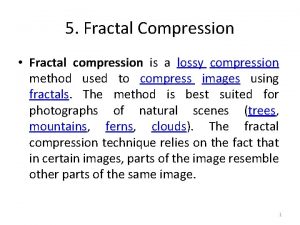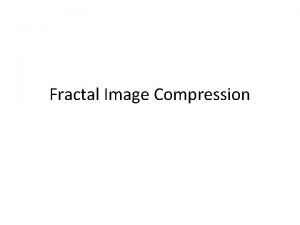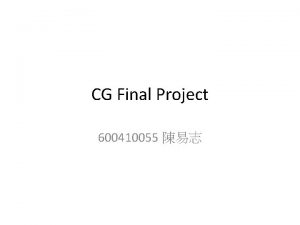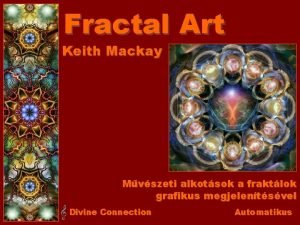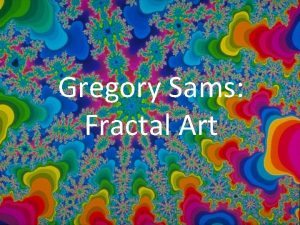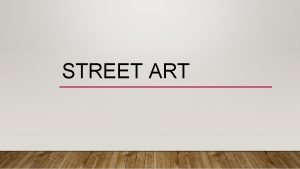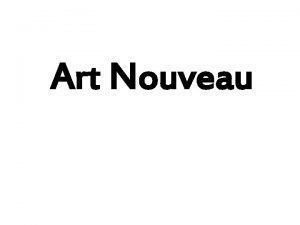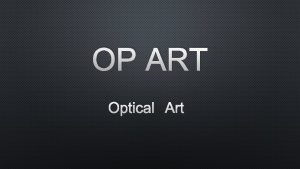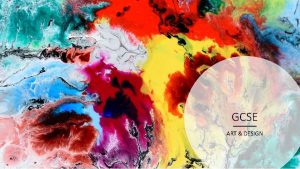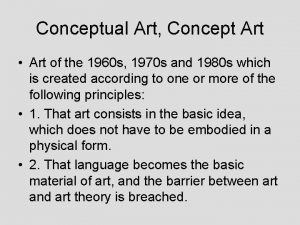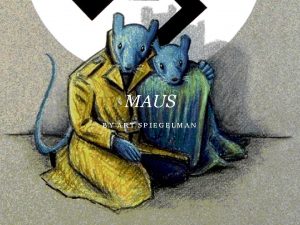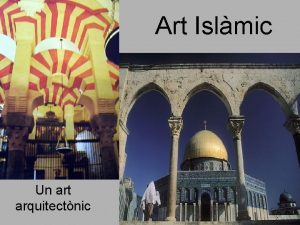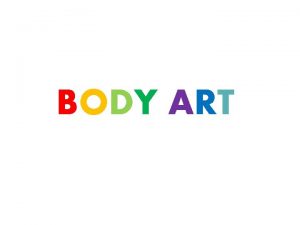Fractal Art What is Fractal Art A fractal























- Slides: 23

Fractal Art

What is Fractal Art? • A fractal is a geometric shape that has self similarity, that is it can be split into pieces that are approximate reduced copies of the whole shape.

Make a Fractal Tree Supplies Needed: • Graph paper • Ruler • Coloured pencils

Trees

Fractal Trees

Draw your own fractal tree • Begin by drawing a straight line vertically on your page. (this will be your trunk) • Add two branches to your trunk that form a v (they should be about 1/3 the size of your trunk) • Off each of those branches make another v 1/3 the size of the last branch • Repeat the pattern

Koch Snowflake • Create a koch snowflake electronically @ http: //math. rice. edu/~lanius/frac/koch. html

Let’s make a Koch Snowflake • Draw an equilateral triangle in the middle of your page (all sides are equal length) • Draw another equilateral triangle opposite to it. Erase the lines to make it appear star like. • Make all the smaller triangles into stars and continue.

Using Technology to Make Fractal Art • Begin with the Fractal genereator @ http: //www. coolmath 4 kids. com/fractals/index. html • will be using Stephen Ferguson's "Tiera-Zon" throughout this tutorial. You can download this program now by clicking here! (Note: This is a zipped file, so click open, then click on the tierazon icon, go extract all, next, save to your folder, next, finish, then click on the icon where you saved it) This should also be now saved to our 5 K and 5 B folders so you can just click on the Tierazon icon in our folder.

Step 1 • 1) This is the opening screen with the basic Mandelbrot image. Pretty plain eh? • However, you are going to see an amazing transformation of this basic image, like an unattractive caterpillar transforming into a beautiful butterfly! 2) On the program toolbar select "Draw", then move your cursor down & click on fractal equation "109". The draw menu contains built in formulas for various types of fractals. Click on several to see the different types, and then return to 109 before proceeding.

Step 2 • • 3) After selectin the 109 equation you should now see the first transformation of the basic image. As you can see, the form is totally different. Now let's move to enhancing this image. Select "Color-1" then click on #20. 4) You now have added your first color variation to your image. Notice the number of color schemes available under "Color-1 & Color-2" on the toolbar. These are just starting points & you will be able to customize these even further! Which takes us to the next step!

Step 3 • 1) There a couple of ways to select the color controls. The easiest is to click your right mouse button directly over the fractal image, and select "color controls". Alternatively, you can select them from programs' left toolbar, and select "C".

Step 4 • ) You will now see a control panel for adjusting the color even further. Change the individual boxes to match the numbers in the image below and hit "Apply". You can also move the "sliders" to adjust numbers on the right side of this window and see the results instantly on your image. Another option is to select Cycle which will automatically cycle through combinations of color. Hit cycle again to stop.

Step 5 • • Before we proceed, let's examine another feature of this program, changing the size of the image. 4) Right click your mouse on the fractal and select XY size. You will then see this window pop up. This will set the width and height of the fractal. Select custom tab, then enter in 120 for both the X & Y dimensions. Click OK or enter on your keyboard. The X dimension changes the horizontal size of the image, Y changes the vertical size of the image. The dimensions we Note: I am demonstrating these commands using the "RIGHT" click feature of your mouse, but all these commands are also available from the left toolbar in Tiera-zon. The "XY" button in this case.

Deep Zooms • We now come to one of the key features of fractal exploration, zooming! We can either zoom into the image, or out! This amazing feature of fractals is infinite in nature. In other words, you can zoom into the mandelbrot image to infinity! Let's explore his feature in these next steps. 1) First we will zoom in on the image. Holding down your left mouse button, draw a square to match what you see in this image. If the square is not where you want it to be, maybe off center a bit, you can left click inside the square & holding the mouse button down, drag the square where ever you would like it. Once you have selected the part of the image that you wish to zoom in on, either click on the magnifying icon on the side toolbar, or hit enter on the keyboard.

• Filters & Julia mode. Time to change the image again! There are many, many "filters" to experiment with in this program. For now, select "Filter-3, 03 "Moving Average 1" from the toolbar, and allow the new image to be drawn. This is a good time to show you how to save an image. Right click over the image, and then select "Save As" from the menu that pops up. Name the file, and choose save. Now if you make changes and are unhappy, you can go back and open this stage of the image. Do this frequently, or you will lose your images forever! Name each file differently every time you save an image, and you will then have copies of every step.

You can Finish Here and Go on to end Project by Clicking “End Project” or Continue

• Let's move on. Holding your left mouse button down, draw another square to match the image, and then select "Julia" mode icon on the side toolbar. (Orange icon). Julia mode can only be used once on an image until it is re-drawn using one of the draw parameters, or the unique editor, which we'll cover later. You can still change other parameters such as color, filters etc. as well as zooming in or out. It will also create a totally different image, depending on what part of the image you select to zoom in on. I have written an entire tutorial dealing with this feature & would recommend going through that tutorial once you are comfortable with all of the basic features that I cover

• Note: This is where your result may look different than mine, this depends entirely on where you draw your square over the image. Even a slight change, up, down, right, or left, will produce a different result. Don't worry if it is not exact, remember, the purpose of this tutorial is not to reproduce this image, but to teach you how to use the program, and how these functions can change & modify the image. Remember what we started with a few steps back? Quite different already! Let's move on!

Changing Fractal Parameters • 1) Right click directly over the image & then select "Fractal Parameters" from the pop up menu • In the new Parameter box fill in the fields to match the ones in this image and select OK. Make sure the numbers are EXACT, especially decimal points, slight variations can make a huge difference! Here are the numbers so that you can copy and paste directly into the input boxes. Julia X: 1. 64281064058502 Julia Y: 0. 097806174204001

• One key factor is the Bailout setting. Often, like the image we started with on this page, the fractal is basically a circle with detail within the circle, and black out side the circle. To extend the detail outward from the center, increase the bailout setting. Change this to 25 and this is the result. The fractal is very different from the previous image, and you now have another tool under your belt to change the fractal! Try changing that number to whatever you wish, and observe the changes. You can set this up to a parameter range of 99999. Change the bailout setting back to 4 before proceeding. • Stopped at page 9 of 15 of notes

Create the Dragon • Create this shape with all lines being the same length • Trace onto tracing paper. Rotate on point 4, 90 degrees clockwise

• Should look like this • Now get your tracing paper and rotate on point 5, 90 degrees
 How to make fractal art
How to make fractal art Fractal saas
Fractal saas What is the area of triangle dfg
What is the area of triangle dfg What is fractal.is
What is fractal.is Arte fractal
Arte fractal Fractal
Fractal Fractal terrains 3
Fractal terrains 3 Fractal market hypothesis
Fractal market hypothesis What do we mean by dimension?
What do we mean by dimension? Ken perlin
Ken perlin Space filling fractal
Space filling fractal Fractal dimension definition
Fractal dimension definition What is a fractal
What is a fractal Proprioceptor
Proprioceptor Fractal image compression example
Fractal image compression example Chaos theory jurassic park
Chaos theory jurassic park Fractal dimension definition
Fractal dimension definition Point processing
Point processing Universo fractal
Universo fractal Fractal curve in computer graphics
Fractal curve in computer graphics Cantor set fractal dimension
Cantor set fractal dimension Art appreciation description
Art appreciation description Renaissance art vs medieval art
Renaissance art vs medieval art Italian renaissance vs northern renaissance
Italian renaissance vs northern renaissance
